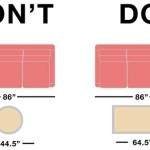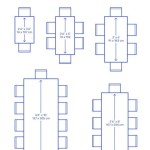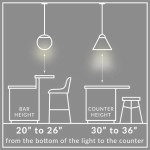Best Height for a Chandelier Over a Dining Table
Selecting the correct height for a chandelier above a dining table is crucial for both aesthetics and functionality. A chandelier hung too high can appear disconnected from the space, failing to provide adequate illumination. Conversely, a chandelier hung too low can obstruct views, create a hazard, and disrupt conversation. Achieving the optimal height requires consideration of several factors, including table size, ceiling height, chandelier dimensions, and the overall design of the dining room.
The primary function of a chandelier over a dining table is to provide ambient and task lighting. It should illuminate the table surface adequately for dining and conversation while simultaneously contributing to the room's overall ambiance. Incorrect placement can render the chandelier ineffective, diminishing both its practical and decorative value. Establishing the correct height ensures the fixture operates as intended, enhancing the dining experience and the room's aesthetic appeal.
Several guidelines are typically employed to determine the ideal height. These guidelines provide a starting point and should be adjusted based on individual circumstances and preferences. It's essential to consider the specific characteristics of the space and the chandelier itself when making the final decision. A well-positioned chandelier can transform a dining room, creating a focal point that enhances the room's style and functionality.
Measuring Ceiling Height and Table Dimensions
The most fundamental aspect of determining chandelier height is understanding the relationship between ceiling height and table dimensions. Standard ceiling heights, typically around 8 feet, require different considerations than those found in rooms with higher ceilings. The size and shape of the dining table are equally important, as these factors influence the visual balance and the amount of light needed. Accurate measurements are essential for making informed decisions about chandelier placement.
For standard 8-foot ceilings, a general rule of thumb is to hang the bottom of the chandelier approximately 30 to 36 inches above the dining table surface. This measurement ensures that the fixture is high enough to avoid obstructing views and conversation, while still providing sufficient light to the table. However, this is a baseline measurement and should be adjusted based on the size and style of the chandelier. A larger, more ornate chandelier may require slightly more clearance.
In rooms with higher ceilings, the chandelier can be hung proportionally higher. For every additional foot of ceiling height beyond 8 feet, add approximately 3 inches to the hanging height. For example, in a room with a 9-foot ceiling, the chandelier could hang 33 to 39 inches above the table. This adjustment maintains the visual balance and prevents the chandelier from appearing too small or insignificant in the larger space. This method is purely for getting an idea on how to hang your chandelier.
The size and shape of the dining table also influence the optimal chandelier height. A larger table requires a larger chandelier, which may necessitate a slightly higher hanging position to prevent it from overwhelming the space. Similarly, a rectangular table may benefit from a slightly longer chandelier, which should be positioned to distribute light evenly across the table surface. The goal is to achieve a harmonious balance between the size of the table, the dimensions of the chandelier, and the ceiling height.
When measuring the ceiling height, it's important to consider any architectural features that may affect the perceived height of the room. Coffered ceilings, beams, or other decorative elements can alter the visual scale and should be taken into account when determining the appropriate chandelier height. Similarly, the presence of other light fixtures in the room, such as recessed lighting or wall sconces, can influence the amount of ambient light needed from the chandelier.
Adjusting for Chandelier Style and Size
Chandelier style and size significantly impact the optimal hanging height. A minimalist, modern chandelier can often be hung slightly lower than a more elaborate, traditional fixture. The chandelier's diameter and vertical height are important factors to consider, as these dimensions determine the fixture's overall visual presence. Heavier or more visually complex chandeliers may require more clearance to prevent them from feeling overwhelming or intrusive.
For chandeliers with a minimalist design, a hanging height slightly below the standard 30-36 inches can be appropriate. These fixtures tend to be less visually imposing and can create a more intimate and focused lighting effect when hung slightly lower. However, it's crucial to ensure that the bottom of the chandelier remains high enough to avoid obstructing views across the table.
Elaborate chandeliers with multiple tiers, crystals, or intricate details often require more vertical space. Hanging these fixtures too low can create a cluttered and overwhelming appearance. In these cases, increasing the hanging height slightly can allow the chandelier to breathe and showcase its design without dominating the space. The specific style and detailing of the chandelier should guide the decision-making process.
The chandelier’s diameter should be proportional to the table’s width. As a general guideline, the chandelier's diameter (in inches) should be approximately half the width of the dining table (in inches). For example, if the dining table is 48 inches wide, the chandelier should ideally have a diameter of around 24 inches. This proportion creates a balanced and visually appealing focal point in the room. The chandelier's height should also be proportional to its diameter, ensuring that the fixture doesn't appear too squat or too elongated.
The overall weight of the chandelier should also be considered. Heavier chandeliers may require stronger support and may benefit from a slightly higher hanging position to distribute the weight more effectively. Additionally, the type of suspension system used to hang the chandelier can influence the perceived height. Chain-hung chandeliers can be easily adjusted, while rod-hung chandeliers typically offer less flexibility.
Considering Personal Preferences and Room Aesthetics
While guidelines provide a solid foundation, personal preferences and the overall aesthetic of the room should ultimately guide the final decision. The goal is to create a space that feels comfortable, inviting, and visually harmonious. Experimentation and subjective evaluation are essential for achieving the desired outcome. Consider the existing décor, the color palette, and the architectural style of the room when determining the optimal chandelier height.
The style of the dining room should influence the choice of chandelier and its placement. A formal dining room may benefit from a more traditional and elaborate chandelier hung at a slightly higher position, while a casual dining room may accommodate a simpler fixture hung at a lower height. The chandelier should complement the overall style and contribute to the room's intended ambiance.
Personal preferences play a crucial role in the final decision. Some people prefer a more dramatic and visually striking lighting arrangement, while others prefer a more subtle and understated effect. Experiment with different hanging heights to determine which arrangement feels most comfortable and appealing. Consider the viewpoints from different locations in the room, such as standing at the entrance or sitting at the table.
The color palette and décor of the dining room should also be taken into account. A chandelier with a bright, reflective finish may appear more prominent and may benefit from a slightly higher hanging position. Conversely, a chandelier with a darker or more muted finish may blend in better with the surroundings and can be hung slightly lower. The goal is to create a sense of visual harmony and balance between the chandelier and the rest of the room.
Ultimately, the best height for a chandelier over a dining table is the one that feels right for the individual and the space. It's essential to consider all of the factors discussed, including ceiling height, table dimensions, chandelier style and size, and personal preferences. By carefully evaluating these elements, it's possible to achieve a lighting arrangement that is both functional and aesthetically pleasing, enhancing the dining experience and the overall ambiance of the room.

How To Guide For Hanging Lights Liven Design

10 Design Tips That This Girl Lives By

Dining Room Chandelier Size Guide Delmarfans Com

Picking The Perfect Chandelier Size For Your Room Hk Interiors

Height For Light Best Sale Over Dining Table

The Right Height To Hang Light Fixtures How Big Long More Kylie M Interiors

Dining Room Chandelier Top Height

How To Choose The Right Size Chandelier Riverbend Home

Light Fixture Height Shop Over Dining Table

Wolberg Lighting Design And Electrical Supply How To Properly Hang A Chandelie








